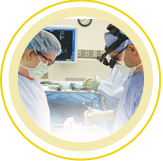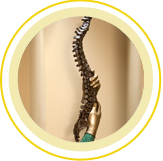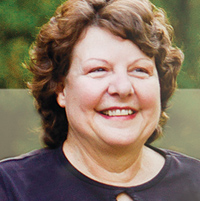
Joyce Cantrell
Greensboro, NC
Adult Scoliosis and Degenerative Disc Disease
“I tell everyone Dr. Cohen is a miracle worker.”
Joyce Cantrell suffered from back and joint problems from an early age, just like her sisters, her mother, her grandmother and her great-grandmother before her. But in 1999, when she was in her early 50s, her discomfort moved to a new level.
The excruciating pain she experienced made it difficult for Joyce, a computer teacher in the Bryan School of Business at the University of North Carolina at Greensboro (UNCG), to perform the job she loved.
She began seeing an orthopaedic specialist.
“I went frequently to see him and to get cortisone shots in my back,” she recalls. “Every time I would see him, he would talk very vaguely about how I needed a long-segment fusion. I didn’t know what that was. He would say, ‘I’m afraid you’re going to topple over.'”
But the surgeon was leery of doing the procedure he felt she needed.
He said, “I’m afraid that if I do surgery, you’re going to collapse.” I said, “Well, don’t you think I need surgery then?” and he said,”Well, I’m not going to touch you and risk making your condition worse.”
Meanwhile, Joyce moved to part-time work as a lecturer at UNCG to reduce the stress on her back. “I went part-time because of the pain, because of the terrible pain,” she says. “I couldn’t bend over. I couldn’t pick things up. I could walk, but it was very difficult. Sometimes the pain went down the back of my legs; sometimes my back just hurt. Sometimes I couldn’t walk at all. I used a cane and a walker. You can imagine trying to teach 19-year-olds when you’re in your 50s – not old – using a cane or a walker. I couldn’t pick up my papers if they fell on the floor. The students would have to, and it was really embarrassing.”
By 2003, her pain had worsened, and her orthopaedist said she would need to take frequent rests if she wanted to continue working, even part-time. He said, “Every hour you need to lie down,” Joyce recalls. “So I had a recliner in my office, a full recliner, one that flattens completely out. Every hour on the hour, I’d lie down for about 10 minutes.”
Outside of work, Joyce had to stop doing things she enjoyed – such as driving herself to Raleigh to see her daughter and grandchildren. Even riding in the car that distance caused pain.
In 2005, Joyce’s orthopaedist told her he wanted to refer her to a scoliosis specialist.
“I had no idea I had scoliosis,” Joyce says. “Nobody had told me that.”
The scoliosis specialist was Max W. Cohen, MD, FAAOS, founder of Spine & Scoliosis Specialists, who came to Greensboro in 2002 after completing double fellowship training in spine and scoliosis surgery at Cornell University’s Hospital for Special Surgery, the top-ranked orthopaedics hospital in the country according to U.S. News & World Report.
Read The Surgeon’s Perspective
Diagnosis
When Joyce saw Dr. Cohen, he explained that in addition to degenerative disc disease, she had adult scoliosis, which was causing her spine to curve into an S shape and collapse on itself.
He said,”You are collapsing at something like 10 times the normal rate for a person your age and weight and so forth,” Joyce recalls. “I still didn’t get it.” Then he said,”If we don’t do this surgery for you soon, you will eventually end up in a wheelchair; your spine will collapse,and you won’t be able to breathe.” Dr. Cohen urged her to have surgery as soon as possible. Joyce, who had seen other relatives end up in wheelchairs as a result of similar problems, resigned her job, effective at the end of the school year and began making plans for surgery. But even as she moved forward, she was convinced her life was over.
“I don’t think people understand that pain and fear go together,” she says. “Even though the doctor says, ‘I’m going to fix you,’ you just can’t believe it. I was in so much pain; I thought there was no way out. I had the minister come over to help me pray for courage. I told my kids that life as I knew it was over.”
Surgery
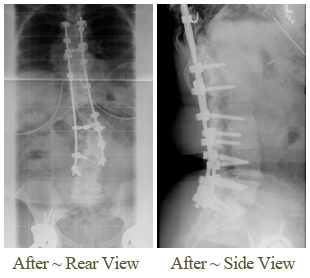
During her surgery in 2005, Dr. Cohen performed a procedure called an osteotomy to break segments of the spine so that it could be straightened. Then, he performed a spinal fusion, using titanium rods and screws to straighten her curved spine and fuse it from T-4 to L-4. Strong pain medication helped her through the first weeks after surgery. Then, gradually she began feeling better as she underwent physical therapy and began resuming normal, everyday tasks. Soon, she was able to get off all pain medications. Within three months, she was driving, and within a year she was back to a normal life.
“Dr. Cohen tells you it takes a year after the surgery, because it really does take a year,” Joyce says.
In 2008, she developed lower back pain due to degenerative disc disease and arthritis. Dr. Cohen performed a second procedure, extending her fusion from L-4 to S-1.
Recovery
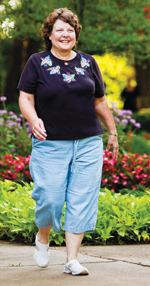
Although there are still some things she can’t do, Joyce is amazed at the difference her surgeries made in her life. She enjoys water aerobics several times a week, walks the treadmill at an exercise center, and walks in her neighborhood with her husband. She also enjoys getting in the car and driving to Raleigh to see her grandkids.
“I take no pain medicine now,” she says. “I haven’t taken any pain medicine since 2008. Before surgery I was taking pain medication, but it really did not help. People have said they could see the pain on my face.”
Were it not for the surgery, she is convinced her life would be very different.
“I am certain I would be in a wheelchair by now at the minimum,” Joyce says. “My grandmother and great-grandmother ended up in wheelchairs, and my mother had a back fusion that did not fuse. My sisters have all had back trouble. I have one sister who’s four years older, and she’s had six back surgeries. She’s going to have another one, and I’m very distressed for her. Her doctors evidently were not as good as mine. They did her neck first, and then they fused pieces of her spine. Between the pieces, her back broke. After that, they had to add bridges, and she did not heal correctly.”
Joyce’s advice to others with back and spine problems?
“I have people in my exercise class who are afraid to go to orthopaedic surgeons,” Joyce says. “I tell them to go to Dr. Cohen. I tell everyone Dr. Cohen is a miracle worker. I recommend him to everybody. In fact, I’ve told my sister who’s going to Johns Hopkins for her next surgery to come down here.” I said, “I know Dr. Cohen could fix your back.”


